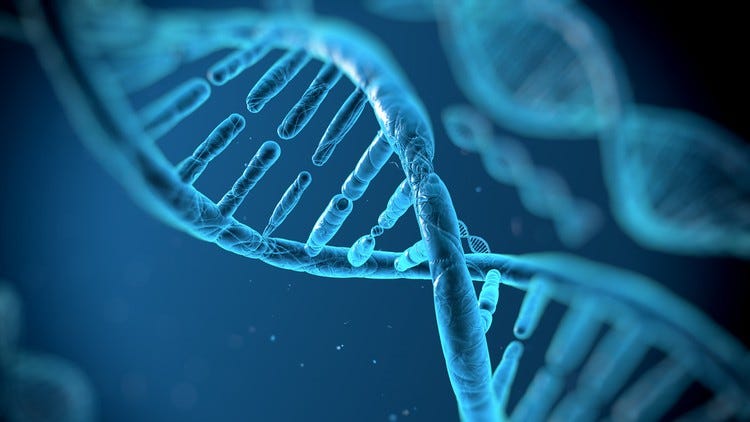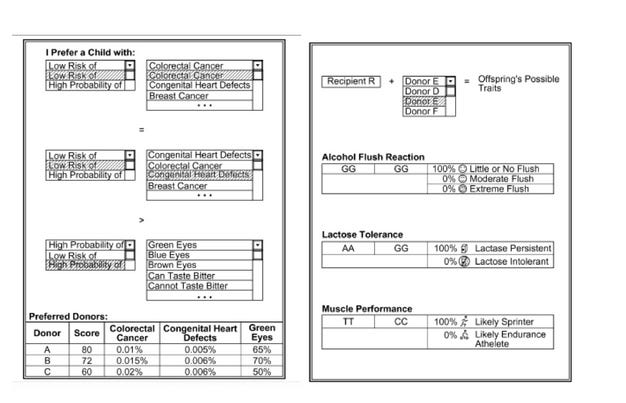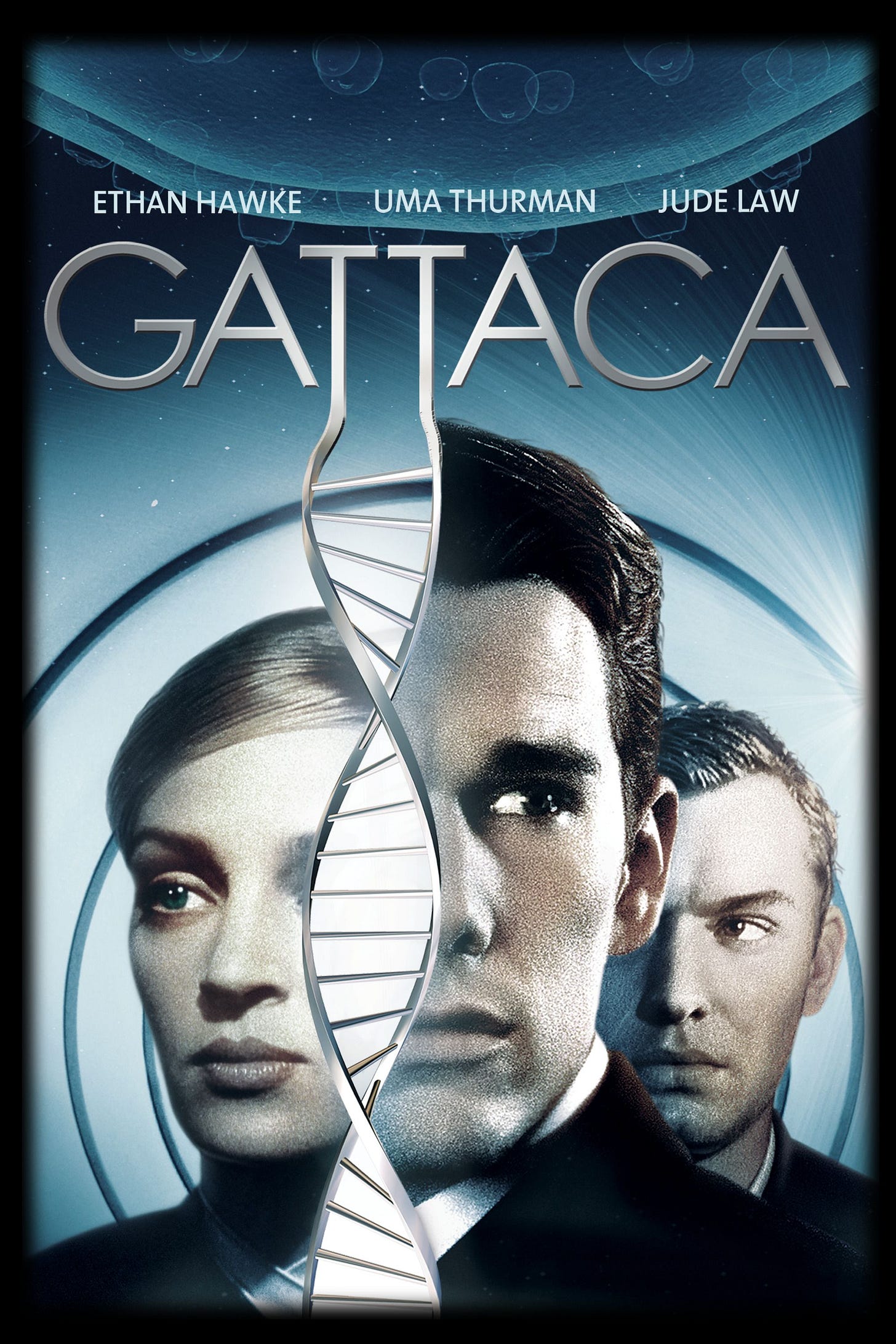Licensed from Shutterstock
GATTACA.
The letters in the 1997 film title stand for the four bases or building blocks (nucleotides) of DNA: adenine (A), cytosine (C), guanine (G), and thymine (T). It is a dystopic science fiction story about the lives of those who are natural born babies and those who are designer babies in our future world. This year marks the 25th anniversary of the film’s release and a time to reflect on its relevance today.
Dolly the Sheep had just been cloned in 19961 and the implications for human genetic engineering became widely apparent, setting the stage for a science fiction movie about what this means for humans. Gene editing was just becoming commercialized for food crops, the first being a tomato, but human gene editing was experimental in the form of gene therapy. The Flavr-Savr Tomato’s valuable shelf-life to feed more people was lost to many with the fearful mantra, “Frankenfood.” All fueling fear of this emerging technology that could reach inside and change the very essence of humanity.
It was not until 2012 that the CRISPR-Cas9 system was invented2 that can be described as a precise pair of scissors for clipping DNA sequences to remove or insert nucleotides. This made possible the ill-fated experiment by He Jiankui, the Chinese researcher in China who genetically engineered twins to be free of HIV. He was found guilty of illegal medical practices and sentenced to three years in prison.3 According to Science magazine, “A court in Shenzhen found that He and two collaborators forged ethical review documents and misled doctors into unknowingly implanting gene-edited embryos into two women, according to Xinhua, China's state-run press agency.”4
Shouldn’t we have seen this coming? Let’s look back at the movie GATTACA and analyze some of the social, ethical and legal issues we could and should see coming. But this ability to genetically engineer humans came more as a wolf wearing sheep’s clothing. It is the unintended consequences of scientific advances to help those couples conceive who othewise, could not.5 But the data to use these techniques to make probability predictions for traits was also required.
How we reverse engineered the human genome
Big data allows us to collect enough information about genes (genotype) and corresponding physical traits (phenotype) to be able to correlate the relationship between the presence of a gene and the appearance of a particular trait. However, it is reverse engineering that has allowed us to distinguish some eye colors, as brown, blue or mottled brown-blue and hair colors such as red, brown or blond. This reverse engineering was done in forensic sciences, where the DNA was eventually matched with a suspect and the correlation with the genotype and phenotype could be estimated. These probabilities were transferable to the PGD technique.
Designer babies are already here?
Designer babies as a concept is not so far in the future. Some might even consider it to have already arrived for the discerning consumer. In fact, the ability to pre-select embryos and to predict a child’s characteristics is already an established practice, with one out of five parents in the U.S. choosing Preimplantation Genetic Diagnosis (PGD). The National Academy of Sciences in July 2018, opened the door to therapeutic gene editing by finding it is acceptable to experiment with human gene editing when the purpose is to cure diseases. Japan announced that they have approved a national policy for editing human embryos. Then, a Chinese scientist, He Jiankui, proclaimed in November 2018 that he had produced the first gene-edited humans.
On March 19, 2019, a World Health Organization committee was appointed in response to the announcement of human gene-editing by the Chinese scientist. Science magazine reported that the 18-member panel agreed that there was an “urgent need” to require registration of all experiments related to human genome editing experiments. They also agreed that it would be “irresponsible at this time for anyone to proceed with clinical applications of human germline genome editing.” However, that would not have prevented He Jiankui from proceeding with his experiment because as the investigation conducted by China showed, he used a forged ethics certificate to authorize his experiment.6
What are our collective opinions on human gene editing?
There are two questions about human gene editing that will drive the acceptability of human gene editing: (1) whether we accept gene editing to prevent a child from having a disease; and (2) whether we accept gene editing to change traits that are purely choices, like gender, eye color and intelligence. You might guess that most people might want to prevent disease but a lot fewer people are comfortable with changing traits because of preference. But this is changing.
In a poll taken in 2003 by the Gallup polling organization, 88% believe that parents should not even be allowed to select traits of their child and should leave it all to chance. And 8% believe parents should be able to select their children’s traits that they want them to have.7 Even if they had a chance to edit out diseases, the vast majority of respondents opposed it.
A 2014 Pew Research Center survey found that 46% of respondents said gene editing was “an appropriate use of medical advances” while 50% said it was “taking medical advances too far” . . . “to modify a baby’s genetic characteristics in order to reduce their risk of serious diseases.” While 83% said that gene editing to increase a baby’s intelligence was “taking medical advances too far,” and only 15% said it was appropriate.8 Greater acceptance of preventing disease reached half of the population, trending toward acceptability for most people.
Traveling forward in time to 2022, a poll in the UK found that 76% of respondents would not approve of changing their baby’s appearance and 71% disapproved of gene editing to make their baby more intelligent.9 However, 82% approved of gene editing to prevent passing on a hereditary genetic disorder.10
This is where a scene from GATTACA can take us right to the parents in this decisionmaking process as they meet with the genetic counselor to design their new child, after having conceiving a child naturally who had a heart defect. Here’s my favorite scene from GATTACA as they face these questions with the genetic counselor:
“Keep in mind this child is you — just the best of you.”
Genetics Counselor, GATTACA
Patents as sentinels of ethics
What part of our humanity are we willing to commercialize? Patents serve as a good sentinel for that question.
Focusing specifically on reproductive technologies, the technologies used to help parents have children are the same ones that are enabling scientists to identify gene causing diseases or genes that are responsible for characteristics, like eye color. Some patents like this one identify viable embryos in 2016.11 However, another patent that was granted to 23&Me (a commercial gene testing company) in 2013 that describes a process where the company can predict the eye color and other traits from parents based on their genetic tests enabling the selection of a partner with the desired profile. The questionnaire for prospective parents (a patent figure) looks like this: "I prefer a child with": "longest expected life span", "least expected life cost of health care", or "least expected cumulative duration of hospitalisation". Other options are "0 per cent likely endurance athlete" and "100 per cent likely sprinter".12
Here is the questionnaire for parents submitted as part of the patent application. It may remind you of the scene with the genetics counselor in GATTACA.
Because patent law does not require screening of patents as to whether they may alter the entire human race, the patentees were never asked about how they intended to use their patent, but some ethicists noticed. Patent law requires consideration of national security concerns in the review of this patent, but only where the federal government has a property interest.13 23&Me received a good bit of public pressure and outrage about their plans for their patent and so they issued a statement on their blog (not available now) saying they did not have any plans to use it now or in the future. That would seem a highly suspect investment for a for-profit organization that planned not to use their investment but this is what passes as acceptable human gene editing regulation today.
Looking ahead to Regulating Designer Babies
Taking some cues from GATTACA, several legal issues to consider in our future. Constitutional equal protection could be the basis of preventing genetic discrimination for designer babies. We have the GINA a federal statute that prevents discrimination because of genetic testing among insurance companies, but we would also need to consider how designer babies might have advantages and others suffer for their lack of genetic perfection. From the earliest school applications through university applications to job applications, guarding against this discrimination would be important to our constitutional equal protection guarantee.
In GATTACA, although discrimination based on genetics is supposed to be illegal, Vincent says "no one takes the law seriously," because to get a job, to find a mate, all relies on checking your DNA.
Other legal issues are readily seen in the area of tort liability. Wrongful death and even wrongful birth (that is an actual tort) have a duty that is breached. If the genetic counselor has a duty to both the child and the parent, then how would that duty be breached? One way might be negligence in failing to eliminate a known lethal disease, with well established techniques for identifying and removing it?
What about a product liability claim for designer babies? There are three types of product liability claims.
Manufacturing defect?
Design defect?
Marketing defect?
Manufacturing defect? For example, in the process of “designing” the baby, damage is done to other genes, the wrong gene is removed, or other “manufacturing” mistakes are made, this could be a manufacturing defect in product liability.
• Strict liability standard? It is possible that Congress could pass a statute to protect baby designer firms, just like the vaccine liability statutes that protect vaccine manufacturers from large liability claims for vaccine injuries. Congress would have to determine that genetic design of babies to prevent disease was a cause worthy of protecting the companies from bankrutcy.
Design defect? This could lead to a class action if designer babies were all designed “incorrectly” from the expected result in a way that caused damages.
Marketing defect? A marketing defect might involve the misuse of the product, leading to injury and damages. For example, designer babies marketed as “Olympic ready” might instead be found to have a physical weakness that results in an injury inconsistent with being “Olympic ready”, or even a mental weakness that makes competition impossible. In GATTACA, is it possible that Jerome, the guaranteed athlete designer baby, and his parents have a marketing defect product liability claim against the baby designer since he only won a silver medal in swimming, not the gold as “promised”?
So it is a good time to reflect on the 25th anniversary of one of the classic science fiction movies that speaks to us 25 years later, and consider are we adequately warned or are we acquiescing to an evitable world of designer babies. Does GATTACA become a commercial message for the services to come?
WATCH: GATTACA Analyzed
https://www.scientificamerican.com/article/20-years-after-dolly-the-sheep-led-the-way-where-is-cloning-now/
https://www.science.org/doi/full/10.1126/science.1225829
https://www.science.org/content/article/chinese-scientist-who-produced-genetically-altered-babies-sentenced-3-years-jail
https://www.science.org/doi/full/10.1126/science.1225829
https://blogs.scientificamerican.com/brainwaves/are-we-too-close-to-making-gattaca-a-reality/
http://www.xinhuanet.com/english/2019-01/21/c_137762633.htm
https://news.gallup.com/poll/7822/americans-reject-notion-gene-selection.aspx
https://www.pewresearch.org/science/2015/07/01/chapter-5-public-views-about-biomedical-issues/
https://yougov.co.uk/topics/politics/explore/issue/Gene_Editing?content=trackers
https://yougov.co.uk/topics/politics/trackers/do-brits-think-gene-editing-should-be-allowed-to-prevent-passing-on-hereditary-genetic-disorders-eg-cystic-fibrosis-or-huntingtons-disease
https://phys.org/news/2021-12-patent-viable-embryos.html (Patented by the office at Texas Tech for whom I have been supplying law students who are getting dual degrees in law and biotechnology for more than a decade.)
https://www.abc.net.au/science/articles/2013/10/04/3862326.htm
https://www.uspto.gov/web/offices/pac/mpep/s115.html







